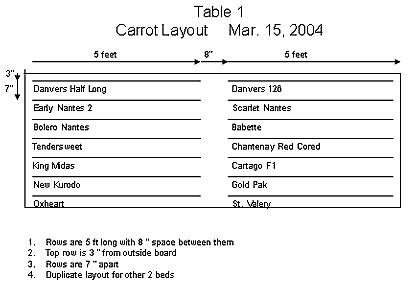Carrots in the Home Garden — 2004
Garden Help > Vegetables > Carrots
Introduction
The carrot study consisted of growing 14 varieties of carrots in three different soil textures and compositions. There were several objectives for the study:
- Determine the best germination method for planting seeds.
- Determine the effect of soil texture on carrot growth.
- Determine the effect of soil composition on carrot flavor.
- Determine the effect of soil composition on carrot shape.
- Determine the effect of soil composition on carrot production.
Study Design
A raised bed was built in which to plant the carrots. The bed was 32 feet long, 4 feet wide and 1 foot high. The soil was removed 6 inches below ground level and replaced with the planting mixture, giving the carrots 16 inches of soil mixture in which to grow. The bed was divided into three equal sections, 10 2/3 feet in length. Each section was filled with a different planting mixture as shown below:
| Mix 1 | Mix 2 | Mix 3 |
| 1/3 compost | 1/3 compost | 1/3 compost |
| 1/3 soil | 1/3 soil | 1/3 soil |
| 1/3 sand | 1/3 perlite | 1/3 soil |
Fourteen varieties of carrots were planted in 5 feet long rows in each section of the raised bed. The varieties selected can easily be found in local stores, nurseries or on-line. The varieties and seed source were:
| Variety | Packet Description | Seed Source |
| Danvers Half Long | "Board shouldered, almost coreless, good taste, rich orange" | Heritage Seeds |
| Danvers 126 | "Strong top and tapered root pull up easily, crisp, sweet taste" | NK Lawn and Garden |
| Early Nantes 2 | "Uniform blunt end roots, outstanding flavor" | Mr. Fothergill's Seeds |
| Scarlet Nantes | "Dependable sweet flavor, crisp texture and bright orange color" | NK Lawn and Garden |
| Bolero Nantes | "Slender cylinder w. blunt tips, deep orange, sweet, brittle texture" | Renee's Garden |
| Babette | Harvest mini or full size, "full sweet flavor, uniform deep orange" | Renee's Garden |
| Tendersweet | "Tapered long with strong tops, sweet, tender" | NK Lawn and Garden |
| Chantenay Red Cored | "Short, thick, crunchy sweet flavor" | NK Lawn and Garden |
| King Midas | "Large, tapered, sweet, deep orange flesh" | Renee’s Garden |
| Cartago F1 | Harvest as mini or full size, "intense orange and sweet flavor" |
Mr. Fothergill's Seeds |
| New Kurodo | Wide at top, long, "one of sweetest, deep orange" | Botanical Interests |
| Gold Pak | "Long, smooth, delicious, red orange, almost coreless" | Heirloom Seeds |
| Oxheart | "Short, thick root, excellent keeper with great taste" | Heirloom Seeds |
| St. Valery | "Smooth uniform roots, thick, sweet, tender flesh" | Heirloom Seeds |
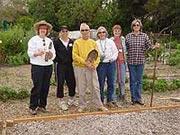
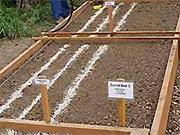
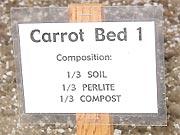
The rows were spaced 7 inches apart with the two outer rows planted 3 inches from the side of the bed, as shown in Table 1.
An irrigation system was installed using 1/4 inch soaker hose and 1/2 inch poly-propylene hose. The 1/2 inch hose was placed horizontally across the bed between the two sets of 7 rows. The 1/4 inch soaker hose was connected to the 1/2 inch hose, running next to the side of the bed and between each row. Before germination, the soaker hose was placed directly on soil above the seeds and then moved to a midpoint between the rows after germination. The soaker hose should be checked for water flow since older hose can shrink and cause less water to flow.
A separate study was conducted to determine the germination rate for carrots using three planting methods. Carrot seeds were planted in three one foot rows and then each row was covered with different materials. The materials used were sand, soil, and vermiculite.
Study Timing
The raised bed was constructed and filled in February. The germination study was done at this time. In late March, the 14 varieties of carrots were planted. A shade cloth was placed over the bed for about one month or until the carrot tops were 4 inches tall. A taste test of the carrots was done the first week of July and all of the carrots were harvested the next week.
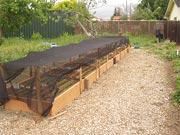
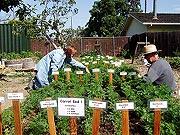
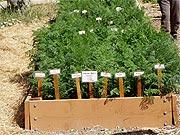
Study Results
Germination Experiment
Twenty-three seeds were planted approximately 3/4 inch apart in each of the compartments of a 9-inch by 13.5-inch plastic container with 2 inches of top soil. Each seed section was covered with 1/4 inch of either top soil, sand or vermiculite and watered regularly and equally with a fine spray. The first seedling appeared on the 9th day. On about day 21, some seedlings in both the vermiculite and the sand began to droop or die. This could be from over or under watering. Thinning of the seedlings was then performed by cutting with scissors. X in the table below denotes dates on which the seedlings were not counted.
Germination Data
Table 2 shows the germination rates for the seed coverings. The best results were achieved with the vermiculite covering. This covering was used for all 14 varieties in this study.
| Day 9 |
Day 10 |
Day 11 |
Day 12 |
Day 13 |
Day 14 |
Day 15 |
Day 16 |
Day 17 |
Day 18 |
Day 19 |
Day 20 |
Day 21 |
Seedlings |
|
| Soil Covered |
0 | 0 | 0 | X | 2 | 2 | 6 | X | X | 6 | 6 | 7 | 7 | No Thinning |
| Sand Covered |
1 | 4 | 6 | X | 9 | 13 | 13 | X | X | 15 | 18 | 18 | 17 | 5 |
| Vermiculite Covered |
5 | 14 | 16 | X | 19 | 19 | 19 | X | X | 21 | 21 | 22 | 19 | 7 |
Taste
Table 3 and 3A is a summary of the taste testing. The taste was very subjective and varied among the tasters. The results are relative and even the carrots which received negative comments had excellent taste. The results indicated that there is no one best soil texture in which to grow carrot for taste. Mix 3 (soil/compost) had the highest rating. Mix 1 (sand/soil/compost) had the lowest ratings. The best soil mixture and taste seems to depend upon the variety being grown.
Table 3: Taste Test Results for First Seven Varieties of Carrots
| Babette | Tendersweet | Chantenay Red Cored |
King Midas | Cartago F1 | Danvers Half Long |
Danvers 126 |
|
| Mix 1 Sand, Compost and Soil |
2 | 2 | 3 | 3 | 1 | 3 | 3 |
| Mix 2 Perlite, Compost and Soil |
1 | 3 | 1 | 2 | 2 | 2 | 1 |
| Mix 3 Soil and Compost |
3 | 1 | 2 | 1 | 3 | 1 | 2 |
| Comments | Bitter in Mix 3 |
Very sweet in Mix 3 | Tender | Crisp Greater flavor in Mix 3 |
Green Taste, Grainy | Sweet, Great taste | |
| Ranking 1 = best tasting | |||||||
Table 3A: Taste Test Results for Second Seven Varieties of Carrots
| Early Nantes 2 | Scarlet Nantes | Bolero Nantes | New Kurodo | Gold Pak | Oxheart | St. Valery | |
| Mix 1 Sand, Compost and Soil |
3 | 3 | 3 | 2 | 3 | 2 | 1 |
| Mix 2 Perlite, Compost and Soil |
1 | 1 | 2 | 3 | 2 | 3 | 2 |
| Mix 3 Soil and Compost |
2 | 2 | 1 | 1 | 1 | 1 | 3 |
| Comments | Bland | Good variety, succulent |
Nice flavor | Bland | Better flavor in Mix 3 |
||
| Ranking 1 = best tasting | |||||||
Production and Shape
Carrots grown in the Mix 3 (soil/compost) were heavier and, in general, longer. Those grown in the Mix 2 (perlite/soil/compost) mixture grew almost as well. The Mix 1 (sand/soil/compost) carrots seemed significantly lighter in weight. These results can be seen by comparing average weight per carrot in Table 4, 4A and 4B. The difference in the total number of carrots in the data is due to thinning. A spacing of at least 1 inch between the carrots was maintained. Because the carrots in the Mix 3 (soil/compost) had larger diameters, it was necessary to remove more carrots to obtain the 1-inch spacing.
A general shape of the carrot can be obtained by calculating the ratio of the top diameter and length for the average carrot for the different varieties. These ratios for carrots grown in the Mix 3 (soil/compost) and the Mix 2 (perlite/soil/compost) mixtures were quite similar, while those grown in the Mix 1 (sand/soil/compost) differed.
Table 4: Soil Type: 1/3 Sand, 1/3 Soil, 1/3 Compost (July 13, 2004)
| Variety | Longest Carrot |
Average Carrot |
Shortest Carrot |
Total Weight (lbs) |
Total No. | Average Weight per Carrot |
||||||
| Length (in.) | Diameter | Length (in.) | Diameter | Length (in.) | Diameter | |||||||
| Top | Bottom | Top | Bottom | Top | Bottom | |||||||
| Danvers Half Long | 4.75 | 0.75 | 0.38 | 3.00 | 0.75 | 0.50 | 1.50 | 0.38 | 0.13 | 1.00 | 37 | 0.03 |
| Danvers 126 | 7.00 | 2.00 | 0.25 | 5.25 | 1.13 | 0.13 | 1.50 | 0.50 | 0.25 | 3.0 | 30 | 0.10 |
| Early Nantes 2 | 6.38 | 0.63 | 0.25 | 4.50 | 0.50 | 0.38 | 1.25 | 0.25 | 0.06 | 1.25 | 35 | 0.04 |
| Scarlet Nantes | 6.50 | 1.00 | 0.25 | 3.50 | 0.75 | 0.06 | 2.06 | 0.38 | 0.13 | 1.75 | 37 | 0.05 |
| Bolero Nantes | 5.25 | 1.00 | 0.25 | 4.75 | 0.75 | 0.25 | 2.75 | 0.25 | 0.06 | 2.75 | 41 | 0.07 |
| Babette | 4.50 | 0.50 | 0.25 | 4.25 | 0.50 | 0.25 | 1.00 | 0.38 | 0.06 | 0.75 | 38 | 0.02 |
| Tendersweet | 8.75 | 1.00 | 0.63 | 5.00 | 0.75 | 0.25 | 2.00 | 0.13 | 0.06 | 3.25 | 58 | 0.06 |
| Chantenay Red Cored | 5.50 | 1.25 | 0.13 | 4.25 | 0.75 | 0.25 | 3.00 | 0.38 | 0.03 | 2.00 | 39 | 0.05 |
| King Midas | 4.75 | 1.75 | 1.75 | 3.00 | 0.75 | 0.50 | 1.75 | 0.38 | 0.38 | 1.50 | 46 | 0.03 |
| Cartago F1 | 6.50 | 0.75 | 0.25 | 6.00 | 0.50 | 0.06 | 3.50 | 0.25 | 0.06 | 0.75 | 29 | 0.03 |
| New Kurodo | 5.25 | 1.75 | 1.50 | 4.00 | 1.50 | 0.75 | 1.75 | 0.75 | 0.50 | 3.50 | 43 | 0.08 |
| Gold Pak | 6.50 | 0.50 | 0.06 | 5.00 | 0.25 | 0.06 | 1.50 | 0.06 | 0.03 | 0.75 | 51 | 0.01 |
| Oxheart | 4.00 | 2.00 | 0.75 | 3.00 | 1.75 | 1.00 | 1.00 | 1.50 | 0.25 | 6.25 | 30 | 0.21 |
| St. Valery | 7.00 | 1.50 | 0.38 | 6.50 | 0.50 | 0.13 | 3.13 | 0.63 | 0.25 | 2.00 | 33 | 0.06 |
| Variety | Shape/Comments | Variety | Shape/Comments |
| Danvers Half Long | Wide at top, long | Chantenay Red Cored | Look healthy, fat, tapers |
| Danvers 126 | Malformed, some are split or have 2 tails | King Midas | Short, cylinders |
| Early Nantes 2 | Narrow, some very short, 1 yellow | Cartago F1 | Long, narrow |
| Scarlet Nantes | Short, cylinders | New Kurodo | Wide at top, tapers, 3 are flaccid, rubbery |
| Bolero Nantes | Nice carrot shapes, some with 2 tails | Gold Pak | Long, very narrow |
| Babette | Short, cylinders | Oxheart | Heart shape |
| Tendersweet | Long, narrow | St. Valery | Wide at top, tapers to bottom, flowering carrot is yellow, very rigid |
Table 4A: Carrot Production and Shape, Soil Type: 1/3 Perlite, 1/3 Soil, 1/3 Compost (July 13, 2004)
| Variety | Longest Carrot |
Average Carrot |
Shortest Carrot |
Total Weight (lbs) |
Total No. | Average Weight per Carrot |
||||||
| Length (in.) | Diameter | Length (in.) | Diameter | Length (in.) | Diameter | |||||||
| Top | Bottom | Top | Bottom | Top | Bottom | |||||||
| Danvers Half Long | 6.25 | 1.25 | 0.25 | 5.50 | 1.00 | 0.13 | 1.75 | 0.50 | 0.06 | 2.25 | 38 | 0.06 |
| Danvers 126 | 6.25 | 1.50 | 0.13 | 3.50 | 1.00 | 0.50 | 1.75 | 0.50 | 0.13 | 1.75 | 26 | 0.07 |
| Early Nantes 2 | 6.25 | 1.00 | 0.25 | 4.00 | 0.75 | 0.25 | 0.75 | 0.13 | 0.06 | 2.00 | 50 | 0.04 |
| Scarlet Nantes | 6.00 | 0.88 | 0.25 | 4.00 | 0.75 | 0.13 | 1.50 | 0.13 | 0.06 | 1.25 | 30 | 0.04 |
| Bolero Nantes | 6.25 | 0.75 | 0.38 | 5.75 | 1.00 | 0.38 | 2.25 | 0.50 | 0.25 | 3.25 | 38 | 0.09 |
| Babette | 4.75 | 0.50 | 0.25 | 4.50 | 0.75 | 0.25 | 1.75 | 0.25 | 0.06 | 1.5 | 35 | 0.04 |
| Tendersweet | 8.25 | 0.75 | 0.25 | 5.75 | 0.50 | 0.13 | 2.75 | 0.50 | 0.13 | 2.00 | 36 | 0.06 |
| Chantenay Red Cored | 6.50 | 1.50 | 0.19 | 5.50 | 1.00 | 0.75 | 2.00 | 0.75 | 0.13 | 4.75 | 35 | 0.14 |
| King Midas | 4.25 | 0.50 | 0.25 | 3.50 | 0.50 | 0.25 | 2.50 | 0.38 | 0.25 | 1.00 | 25 | 0.04 |
| Cartago F1 | 7.75 | 1.00 | 0.75 | 5.00 | 0.75 | 0.13 | 3.50 | 0.25 | 0.13 | 2.13 | 30 | 0.07 |
| New Kurodo | 6.00 | 1.25 | 0.25 | 4.50 | 0.75 | 0.50 | 2.25 | 0.25 | 0.13 | 1.75 | 30 | 0.06 |
| Gold Pak | 9.50 | 0.75 | 0.13 | 5.50 | 0.50 | 0.13 | 1.25 | 0.25 | 0.06 | 1.63 | 32 | 0.05 |
| Oxheart | 3.75 | 3.00 | 1.00 | 3.00 | 1.50 | 0.75 | 1.00 | 0.25 | 0.13 | 3.00 | 28 | 0.11 |
| St. Valery | 8.50 | 1.75 | 0.25 | 6.00 | 1.25 | 1.50 | 1.50 | 0.25 | 0.19 | 4.50 | 34 | 0.13 |
| Variety | Shape/Comments | Variety | Shape/Comments |
| Danvers Half Long | Wide at top, long | Chantenay Red Cored | Look healthy, fat, tapers |
| Danvers 126 | Malformed, some are split or have 2 tails | King Midas | Short, cylinders |
| Early Nantes 2 | Narrow, some very short, 1 yellow | Cartago F1 | Long, narrow |
| Scarlet Nantes | Short, cylinders | New Kurodo | Wide at top, tapers, 3 are flaccid, rubbery |
| Bolero Nantes | Nice carrot shapes, some with 2 tails | Gold Pak | Long, very narrow |
| Babette | Short, cylinders | Oxheart | Heart shape |
| Tendersweet | Long, narrow | St. Valery | Wide at top, tapers to bottom, flowering carrot is yellow, very rigid |
Table 4B: Carrot Production and Shape, Soil Type: 2/3 Soil, 1/3 Compost (July 13, 2004)
| Variety | Longest Carrot |
Average Carrot |
Shortest Carrot |
Total Weight (lbs) |
Total No. | Average Weight per Carrot |
||||||
| Length (in.) | Diameter | Length (in.) | Diameter | Length (in.) | Diameter | |||||||
| Top | Bottom | Top | Bottom | Top | Bottom | |||||||
| Danvers Half Long | 9.00 | 3.00 | 0.25 | 6.50 | 1.25 | 0.25 | 0.75 | 0.13 | 0.06 | 3.00 | 29 | 0.10 |
| Danvers 126 | 7.25 | 2.00 | 0.25 | 5.50 | 1.38 | 0.25 | 1.50 | 0.63 | 0.25 | 6.25 | 33 | 0.19 |
| Early Nantes 2 | 7.00 | 1.38 | 0.25 | 4.25 | 1.00 | 0.50 | 1.50 | 0.38 | 0.13 | 2.00 | 29 | 0.07 |
| Scarlet Nantes | 7.00 | 1.13 | 0.63 | 5.75 | 1.00 | 0.63 | 2.25 | 0.50 | 0.25 | 6.25 | 35 | 0.18 |
| Bolero Nantes | 6.75 | 1.00 | 0.50 | 6.00 | 1.00 | 0.25 | 1.50 | 0.50 | 0.25 | 3.25 | 36 | 0.09 |
| Babette | 4.75 | 1.13 | 0.63 | 4.25 | 0.75 | 0.50 | 2.00 | 0.38 | 0.25 | 2.00 | 31 | 0.06 |
| Tendersweet | 7.75 | 0.88 | 0.25 | 7.00 | 1.00 | 0.25 | 1.75 | 0.38 | 0.25 | 2.50 | 27 | 0.09 |
| Chantenay Red Cored | 5.50 | 2.00 | 0.38 | 5.25 | 1.75 | 0.25 | 2.75 | 0.50 | 0.13 | 7.00 | 32 | 0.22 |
| King Midas | 4.50 | 0.50 | 0.50 | 4.25 | 0.50 | 0.38 | 2.25 | 0.50 | 0.38 | 0.75 | 15 | 0.05 |
| Cartago F1 | 8.00 | 0.63 | 0.25 | 6.25 | 0.88 | 0.38 | 2.75 | 0.25 | 0.13 | 3.75 | 26 | 0.14 |
| New Kurodo | 6.50 | 1.50 | 0.50 | 4.63 | 1.38 | 0.25 | 2.75 | 0.63 | 0.25 | 2.50 | 18 | 0.14 |
| Gold Pak | 8.00 | 1.00 | 0.25 | 6.25 | 0.75 | 0.25 | 2.25 | 0.50 | 0.25 | 2.25 | 27 | 0.08 |
| Oxheart | 4.50 | 2.00 | 0.50 | 3.25 | 2.13 | 0.38 | 2.50 | 1.25 | 0.50 | 4.00 | 20 | 0.20 |
| St. Valery | 5.00 | 1.25 | 0.25 | 5.00 | 1.00 | 0.25 | 3.00 | 0.63 | 0.13 | 3.13 | 24 | 0.13 |
| Variety | Shape/Comments | Variety | Shape/Comments |
| Danvers Half Long | Wide at top, long, rough skin | Chantenay Red Cored | Wide at top, some tapering |
| Danvers 126 | Wide at top, some malformed | King Midas | Short, cylinders |
| Early Nantes 2 | Some long, some very short | Cartago F1 | Long, narrow |
| Scarlet Nantes | Some long, some short cylinders | New Kurodo | Wide at top, tapers, 1 yellow carrot |
| Bolero Nantes | Long cylinders | Gold Pak | Long, narrow |
| Babette | Cylinders | Oxheart | Heart shape |
| Tendersweet | Long, narrow | St. Valery | Malformed, many with 2 tails |
by Jackye Churchill and Ken Witthaus







